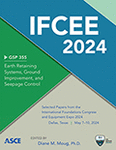Short-Term Changes in Soil Aggregate Stability in Biopolymer-Amended, Coarse-Grained Soil
Publication: IFCEE 2024
ABSTRACT
This project aims to quantify how soil aggregate stability changes over time in biopolymer-amended, coarse-grained soil. Biopolymers, which are naturally occurring polymers that are found in living organisms, have been identified as possible materials to use for ground improvement. However, commonly used biopolymers such as xanthan gum and guar gum can be broken down and used by microorganisms in soil. Consequently, prior experiments have not explicitly considered how soil properties change due to biopolymer amendment degradation. To study biopolymer persistence in soil, unamended and biopolymer-amended (1.0% w/w xanthan gum and guar gum) coarse-grained soil samples were incubated in a greenhouse for 0, 5, 15, 30, 60, and 100 days. Following the greenhouse maturation time, soluble polysaccharide content and aggregate stability were measured for all soil samples. Soluble polysaccharide content decreased over time for both the guar gum and xanthan gum amended soils, indicating biopolymer degradation. However, after an initial decrease, aggregate stability increased rapidly for the biopolymer-amended soils, reaching 80%–90% by day 100. These results suggest that biopolymer effects on soil properties persist even as components of the biopolymer degrade within the soil.
Get full access to this chapter
View all available purchase options and get full access to this chapter.
REFERENCES
Antonette, J., Donza, J., Jaradat, K. A., Darbari, Z., and Abdelaziz, S. L. (2019). Filler-Stabilized Xanthan Gum for Soil Improvement. Geo-Congress 2019, 125–133. https://doi.org/10.1061/9780784482117.011.
Ayeldeen, M. K., Negm, A. M., and El Sawwaf, M. A. (2016). Evaluating the physical characteristics of biopolymer/soil mixtures. Arabian Journal of Geosciences, 9(5), 371. https://doi.org/10.1007/s12517-016-2366-1.
Chang, I., Im, J., and Cho, G.-C. (2016). Introduction of Microbial Biopolymers in Soil Treatment for Future Environmentally-Friendly and Sustainable Geotechnical Engineering. Sustainability, 8(3), 251. https://doi.org/10.3390/su8030251.
Chang, I., Im, J., Prasidhi, A. K., and Cho, G.-C. (2015). Effects of Xanthan gum biopolymer on soil strengthening. Construction and Building Materials, 74, 65–72. https://doi.org/10.1016/j.conbuildmat.2014.10.026.
DuBois, M., Gilles, K. A., Hamilton, J. K., Rebers, P. A., and Smith, F. (1956). Colorimetric Method for Determination of Sugars and Related Substances. Analytical Chemistry, 28(3), 350–356. https://doi.org/10.1021/ac60111a017.
Kemper, W., and Rosenau, R. (1986). Aggregate stability and size distribution. In A. Klute (Ed.), Methods of Soil Analysis (pp. 425–442). ASA (Agronomy Monograph 9).
Khatami, H. R., and O’Kelly, B. C. (2013). Improving Mechanical Properties of Sand Using Biopolymers. Journal of Geotechnical and Geoenvironmental Engineering, 139(8), 1402–1406. https://doi.org/10.1061/(ASCE)GT.1943-5606.0000861.
Land, L., White, J. R., and Gambrell, R. P. (2011). Microbial Response to Potential Soil-Stabilizing Polymer Amendments for Coastal Wetland Restoration. Soil Science Society of America Journal, 75(6), 2398–2406. https://doi.org/10.2136/sssaj2011.0017.
Latifi, N., Horpibulsuk, S., Meehan, C. L., Abd Majid, M. Z., Tahir, M. M., and Mohamad, E. T. (2017). Improvement of Problematic Soils with Biopolymer—An Environmentally Friendly Soil Stabilizer. Journal of Materials in Civil Engineering, 29(2), 04016204. https://doi.org/10.1061/(ASCE)MT.1943-5533.0001706.
Muguda, S., Hughes, P. N., Augarde, C. E., Perlot, C., Walter Bruno, A., and Gallipoli, D. (2022). Cross-linking of biopolymers for stabilizing earthen construction materials. Building Research & Information, 50(5), 502–514. https://doi.org/10.1080/09613218.2021.2001304.
Olagoke, F. K., Bettermann, A., Thi, P., Nguyen, B., Redmile, M., and Doreen, G. (2022). Importance of substrate quality and clay content on microbial extracellular polymeric substances production and aggregate stability in soils. Biology and Fertility of Soils, 435–457. https://doi.org/10.1007/s00374-022-01632-1.
Reddy, J. J., and Varaprasad, B. J. S. (2021). Long-term and durability properties of xanthan gum treated dispersive soils – An eco-friendly material. Materials Today: Proceedings, 44, 309–314. https://doi.org/10.1016/j.matpr.2020.09.472.
Redmile-Gordon, M. A., Brookes, P. C., Evershed, R. P., Goulding, K. W. T., and Hirsch, P. R. (2014). Measuring the soil-microbial interface: Extraction of extracellular polymeric substances (EPS) from soil biofilms. Soil Biology and Biochemistry, 72, 163–171. https://doi.org/10.1016/j.soilbio.2014.01.025.
Sharma, G., Sharma, S., Kumar, A., Al-Muhtaseb, A. H., Naushad, M., Ghfar, A. A., Mola, G. T., and Stadler, F. J. (2018). Guar gum and its composites as potential materials for diverse applications: A review. Carbohydrate Polymers, 199, 534–545. https://doi.org/10.1016/j.carbpol.2018.07.053.
Smith, D. J., Snead, M., and Wynn-Thompson, T. M. (2022). Soil Amended with Organic Matter Increases Fluvial Erosion Resistance of Cohesive Streambank Soil. JGR Biogeosciences, 1–22. https://doi.org/10.1029/2021JG006723.
Soldo, A., and Miletic, M. (2022). Durability against Wetting-Drying Cycles of Sustainable Biopolymer-Treated Soil. Polymers, 14(19), 4247. https://doi.org/10.3390/polym14194247.
Soldo, A., Miletić, M., and Auad, M. L. (2020). Biopolymers as a sustainable solution for the enhancement of soil mechanical properties. Scientific Reports, 10(1), 267. https://doi.org/10.1038/s41598-019-57135-x.
Sujatha, E. R., Atchaya, S., Sivasaran, A., and Keerdthe, R. S. (2021). Enhancing the geotechnical properties of soil using xanthan gum—An eco-friendly alternative to traditional stabilizers. Bulletin of Engineering Geology and the Environment, 80(2), 1157–1167. https://doi.org/10.1007/s10064-020-02010-7.
Wynn, T., and Mostaghimi, S. (2006). The Effects of Vegetation and Soil Type on Streambank Erosion, Southwestern Virginia, USA. Journal of the American Water Resources Association, 42(1), 69–82.
Information & Authors
Information
Published In
History
Published online: May 3, 2024
ASCE Technical Topics:
- Aggregates
- Chemical degradation
- Chemical processes
- Chemistry
- Coarse-grained soils
- Engineering materials (by type)
- Environmental engineering
- Geomechanics
- Geotechnical engineering
- Infrastructure
- Materials engineering
- Pavements
- Polymer
- Soil dynamics
- Soil mechanics
- Soil properties
- Soil stabilization
- Soils (by type)
- Synthetic materials
- Transportation engineering
Authors
Metrics & Citations
Metrics
Citations
Download citation
If you have the appropriate software installed, you can download article citation data to the citation manager of your choice. Simply select your manager software from the list below and click Download.
